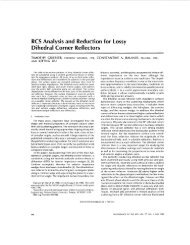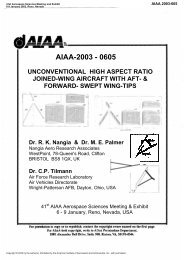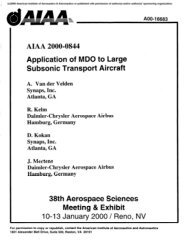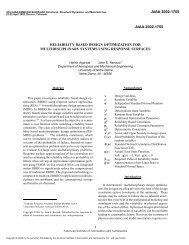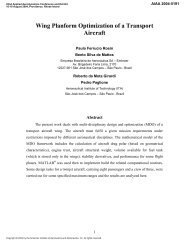Overview of MM and UTD methods at the Ohio State University ...
Overview of MM and UTD methods at the Ohio State University ...
Overview of MM and UTD methods at the Ohio State University ...
Create successful ePaper yourself
Turn your PDF publications into a flip-book with our unique Google optimized e-Paper software.
approxim<strong>at</strong>e morecomplexones. The basic shapes are mul-<br />
2<br />
tiple-sided fl<strong>at</strong> pl<strong>at</strong>es, multiple-section cone frustums, <strong>and</strong><br />
-40t ' I<br />
-SOL I I I t I<br />
180 I20 60 0<br />
TAIL ANGLE NOSE<br />
Fig. 9. <strong>UTD</strong> calcul<strong>at</strong>ed near zone backsc<strong>at</strong>ter p<strong>at</strong>tern from<br />
a cone-cylinder geometry <strong>at</strong> 864-in. range, horizontal polar-<br />
iz<strong>at</strong>ion, <strong>and</strong> 10 GHr.<br />
-<br />
D -<br />
20:<br />
0<br />
5<br />
m -20<br />
cn<br />
U<br />
(r<br />
-40<br />
-60 180 90 0<br />
TAIL ANGLE NOSE<br />
Fig. 10. Measured backsc<strong>at</strong>ter p<strong>at</strong>tern from a cone-cylin-<br />
der geometry <strong>at</strong> 864-in. range, horizontal polariz<strong>at</strong>ion, <strong>and</strong><br />
10 CHz.<br />
manner. It is still necessary to provide transition functions<br />
th<strong>at</strong> correct <strong>the</strong> ray picture in some cases. For example, <strong>the</strong><br />
sc<strong>at</strong>tering from a circular rim can be found in closed form<br />
[41] for <strong>the</strong> bist<strong>at</strong>ic sc<strong>at</strong>tering case. In addition, <strong>the</strong> bist<strong>at</strong>ic<br />
sc<strong>at</strong>tering in <strong>the</strong> specular region <strong>of</strong> <strong>the</strong> side <strong>of</strong> a cone frus-<br />
tum can be found [42]. With <strong>the</strong>se techniques <strong>the</strong> bist<strong>at</strong>ic<br />
sc<strong>at</strong>tering from a cylinder or cone frustum <strong>of</strong> any size can<br />
be calcul<strong>at</strong>ed by just summing <strong>the</strong> sc<strong>at</strong>tering from up to<br />
four points.<br />
The corner diffraction coefficient can also be taken care<br />
<strong>of</strong> using modern equivalent current concepts [27], [28]. With<br />
this technique <strong>the</strong> bist<strong>at</strong>ic sc<strong>at</strong>tering from a multiple-sided<br />
fl<strong>at</strong> pl<strong>at</strong>e can be found by summing terms from only <strong>the</strong><br />
corners <strong>of</strong> <strong>the</strong> pl<strong>at</strong>e or complex structure made up <strong>of</strong> pl<strong>at</strong>e<br />
facets.<br />
A computer code called <strong>the</strong> radar cross section-basic<br />
sc<strong>at</strong>tering code (RCS-BSC) is being developed [43], which<br />
will provide <strong>the</strong> far zone sc<strong>at</strong>tering from complex struc-<br />
tures using <strong>the</strong>se techniques. It uses basic shapes to<br />
finite-composite section ellipsoids <strong>at</strong> <strong>the</strong> present time.<br />
The RCS-BSC will include some pl<strong>at</strong>e-to-pl<strong>at</strong>e interac-<br />
tions. In prepar<strong>at</strong>ion <strong>of</strong> underst<strong>and</strong>ing wh<strong>at</strong> needs to be<br />
included in <strong>the</strong>se situ<strong>at</strong>ions in a <strong>UTD</strong> sense, a two-dimen-<br />
sional code has been developed [44]. This code includes up<br />
to <strong>and</strong> including all third order interactions between two<br />
pl<strong>at</strong>es. In addition, some fourth order interaction terms<br />
have been included. This code is ideal for analyzing<br />
dihedral configur<strong>at</strong>ions. It is necessary to include only <strong>the</strong><br />
diffraction from <strong>the</strong> edges <strong>and</strong> <strong>the</strong>ir reflection in <strong>the</strong> o<strong>the</strong>r<br />
pl<strong>at</strong>e. In addition, double diffraction between edges with<br />
possible intervening reflections have been included. The<br />
newly developed far zone double diffraction coefficients<br />
[29]are used. With this formul<strong>at</strong>ion for double, it is not nec-<br />
essary to use false edges, or imposed edges as some people<br />
call <strong>the</strong>m. As an example, a 9-in. two-dimensional dihedral<br />
has been analyzed in <strong>the</strong> E-plane using <strong>UTD</strong> as shown in<br />
Fig. 11 <strong>and</strong> <strong>MM</strong> as shown in Fig. 12 <strong>at</strong> 10 GHz. Note th<strong>at</strong> <strong>the</strong><br />
two agree very well even in <strong>the</strong> low-level regions.<br />
The interaction between pl<strong>at</strong>es <strong>and</strong> curved surfaces can<br />
also be h<strong>and</strong>led in a similar way as in <strong>the</strong> near zone [45], [46].<br />
0<br />
5 -20<br />
W<br />
-30-<br />
+-I /--<br />
-401 I I I I 1 I<br />
0 90 180<br />
ANGLE<br />
Fig. 11. Backsc<strong>at</strong>ter from a two-dimensional 9-in. dihedral<br />
<strong>at</strong> 10 GHz in <strong>the</strong> E-plane calcul<strong>at</strong>ed using <strong>UTD</strong>.<br />
0 90 180<br />
ANGLE<br />
Fig. 12. Backsc<strong>at</strong>ter from a two-dimensional 9-in. dihedral<br />
<strong>at</strong> 10 CHz in <strong>the</strong> E-plane calcul<strong>at</strong>ed using <strong>MM</strong>.<br />
NEWMAN AND MARHEFKA: Mh4 AND <strong>UTD</strong> METHODS AT OHIO STATE UNIVERSITY 705<br />
1


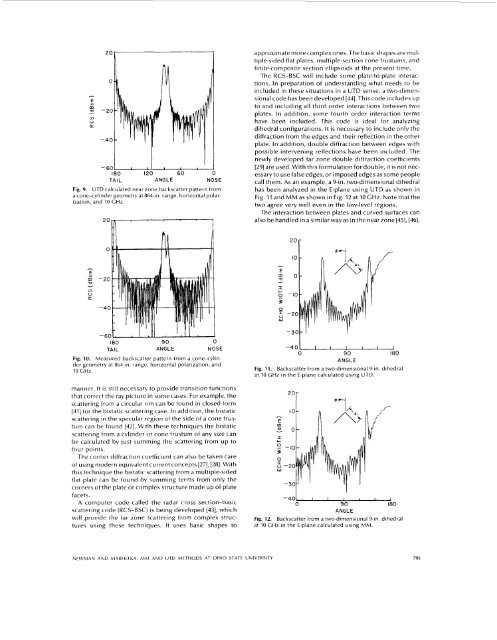





![Introduction to RF Stealth [Book Review] - Antennas and ...](https://img.yumpu.com/16857890/1/190x245/introduction-to-rf-stealth-book-review-antennas-and-.jpg?quality=85)
